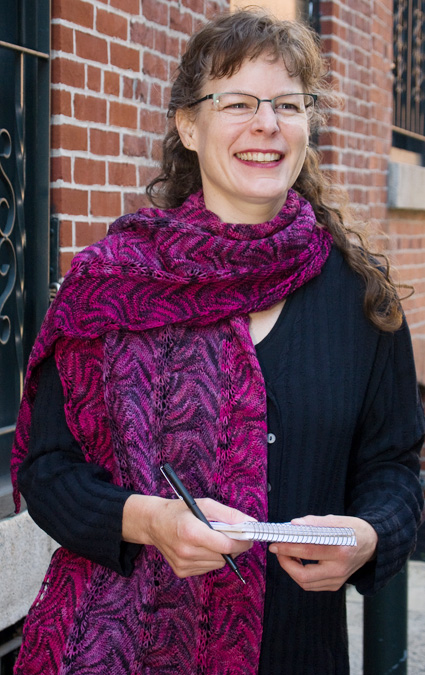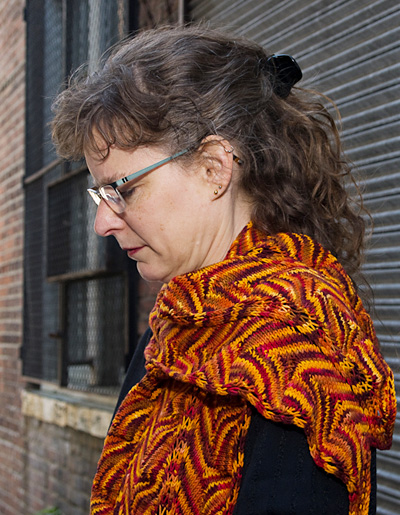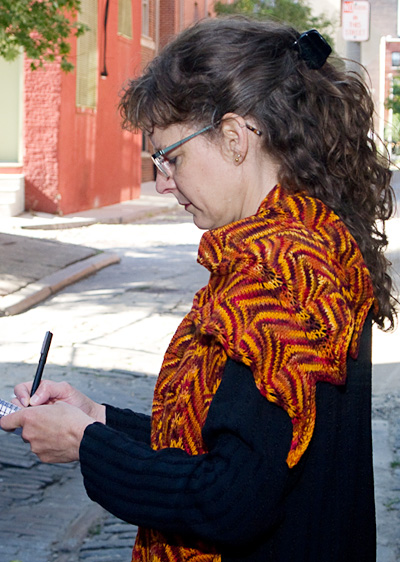

|
|
|

Serendipia is Spanish for Serendipity, and means "fortunate happenstance". We find it everywhere in our lives when we are open to it and allow it to guide us to new experiences. I've been wanting to find a way to harness the stripyness of self-striping yarn in pieces other than socks. So I created a scarf and a wrap that are built from narrow strips that make the most of the sort of short, repeated color changes in hand-painted yarn. To further accentuate the sinuous curves, I developed a decrease that is mostly invisible on the front side of the fabric. When I was designing this travelling chevron, the stripes became swirls when I repeated the motif. In fact, I was planning to create a different chevron-based effect as I began entering my pattern into stitch-maps.com. I accidentally hit the "go for it!" button before I had finished. It generated my partial pattern with a couple of vertical repeats — with these marvelous swirls. It was a very happy accident. ¡Serendipia por cierto! (Serendipity indeed!) Serendipia is worked in long, narrow strips starting and ending with linen-stitch edges: You knit one strip, then pick up every stitch along the left-hand edge, cast on another set of stitches and knit the second strip, attaching it to the first strip as you go. Work up additional strips depending on how much yarn you have. It is ideal to weigh your yarn as you knit so that you can make the most of your yarn and not run out. You can follow my basic instructions and end up with whatever patterning your yarn delivers at that number of stitches, or you can customize the width of your piece so that you achieve the best stripyness for your particular yarn. The pattern is easily adaptable to different yarn weights and lengths of color repeats. |
||
|
|
||
|
SIZE |
|
|
FINISHED MEASUREMENTS |
|
MATERIALS Scarf, Orange (shown below): Note: needles with sharp tips (e.g. Lace needles) are very helpful for working the decrease. Notions |
|
GAUGE Note: While not critical, a different gauge will change the size of your piece and the amount of yarn required. Make sure to swatch and wet block to ensure you get a fabric you like. |
|
PATTERN NOTES |
|
Center Decreases: One 3-to-1 decrease is done on every RS and WS row, appearing as a chain on the WS of the fabric, and traveling diagonally left from the center. Center decreases line up vertically from one row to the next. See instructional video: https: //youtu.be/4Loy2IKpHv0. CDR (Center Decrease, worked on RS): With yarn in front, slip next 2 sts tog through the back loops, slip first st (putting tip of left needle through front loop) back to left needle (to untwist it), p2tog, psso. CDW (Center Decrease, worked on WS): With yarn in back, slip next 2 sts tog knitwise, slip first stitch back knitwise to left needle, k2tog, psso. To ctr: work patt to 1 st bef center decrease Calculations Used in this Piece: This pattern provides you with a choice in the number of stitches to use because yarns are dyed differently and color repeats are different lengths depending on the size of the skein. For you to achieve the color patterning you like you will begin by doing some simple calculations to determine how to achieve this patterning throughout your piece. The samples shown emphasize striping, but you can choose numbers that force your colors to pool. On Size and Measurements and Gauge The samples were worked at the same gauge, and with the following numbers, and with the following number of strips:
The length of the piece is determined by how many rows in your Typical Repeat, and how many repeats you work. The width of the piece is set by the number of strips worked and the number of stitches you cast on for each strip. The number of strips you can work depends on the yardage you have. |
|
DIRECTIONS 
You will need to knit a swatch to see how your particular yarn stripes (or pools, if you prefer), and to check needle size and gauge. Determine the number of stitches in one color repeat of your yarn. Cast on 27 sts using a long-tail cast-on. Row 1 [WS]: P all. Place one removable marker or safety pin through the yarn at the start and one marker at the end of the next full color repeat in the yarn. Note: Work Rows 3 & 4 until you have worked all the stitches between the two markers. As you work, keep track of the number of stitches worked between the first and second markers. This is the number of stitches in one color repeat.Example: 81. Row 3 [WS]: P to ctr, CDW, p to last 2 sts, drop yo, p1. (27 sts) Determine the numbers that make up a single pattern repeat.
The Pattern uses the letters for the instructions. Enter yours here:
Use the online calculator to provide you with B, C, and D, and for customized written instructions. You can open it in Excel or Open Office, or upload it to Google Sheets. Make your swatch (see samples below). Choose a needle size that you would use for stockinette stitch. The denser your knitting, the more invisible your center decreases will be on the RS. Using a long-tail, cast-on your number of stitches [A] and work two repeats of Typical Repeat. Decide if you like the way the colors stripe. If so, cast off and block. If you don't like the striping (or pooling), make some adjustments (adding or removing even one stitch to the cast on number is enough to make a difference), and try again. Once you find a patterning you like, cast off and block.
 First Strip Setup Using the Long Tail method, CO your number of stitches: [A]. Remove these stitches and measure the length of your tail end. Now add enough length to this tail so that you have enough length to cast on for each strip, plus one additional length for your initial cast-on. (The cast-ons for your next strips will use the live yarn and this tail.) CO [A] sts for your first strip; tie the additional tail up in a tidy knot so it doesn't get in the way, or loop it around a bobbin. First Strip, First Repeat If A is an odd number, work Row 1 as follows: If A is an even number, work Row 1 as follows: Row 2 [RS]: K1, yo, [k1, m1o] 3 times, sl1 wyif, [k1, sl1 wyif] over [B-8] sts, CDR, sl1 wyif, [k1, sl1 wyif] to last 2 sts, m1o, k2. (3 sts increased.) Note: After working Row 2 there should be [B] sts to the right of the center decrease, including the yarnover. Row 3 [WS]: P2, [sl1 wyib, p1] to ctr, CDW, p1, [sl1 wyib, p1] to last 5 sts, p3, drop yo, p1. (3 st decreased). Repeat Rows 4-5 until you have worked a total of [D+1] rows ([D] center decreases). You have completed [D] center-decrease rows, and there should be [C] stitches to the left of the center decrease (as viewed from RS). First Strip, Typical Repeat Row 1 [RS]: K1, yo, [k1, m1o] 3 times, k[B-8] to ctr, CDR, k to last 2 sts, m1o, k2 (3 sts increased.) Note: After working Row 1 there should be [B] sts to the right of the center decrease, including the yarnover. Row 2 [WS]: P to ctr, CDW, p to last 2 sts, drop yo, p1. (3 sts decreased) Repeat Rows 3-4 until you have a total of [D] rows. You have completed [D] center-decrease rows, and [C] stitches remain to the left of the center decrease. First Strip, Continuing First Strip, Final Repeat Row 1 [RS]: K1, yo, [k1, m1o] 3 times, k[B-8] to ctr, CDR, k to last 2 sts, m1o, k2. (3 sts increased.) Note: After working Row 1 there should be [B] sts to the right of the center decrease, including the yarnover. Row 2 [WS]: P to ctr, CDW, p to last 2 sts, drop yo, p1. (3 sts decreased) Repeat Rows 3-4 until you have a total of [D minus 4] rows. First Strip, Top Edge: At this point you should determine that you have used just a bit less than one quarter, one third, or one half of your yarn (depending on the number of strips you plan to work). You need about .1 oz/3gm to set up for the next strip and if that tips you over the fraction, then you risk running out of yarn. If you're concerned, rip back one or more of the Typical Repeats to achieve the proper amount. Next Strip, Setup Note: If you have too many or too few picked up stitches it means you worked too many or too few rows in one of your repeats. Count every row (the WS decreases make this easy!) to figure out where you did this. Then place a marker in that repeat as a reminder, and match this incorrect number of rows at the same place when you work your next strip. This will ensure that your curves line up. Next Strip, First Repeat With an odd-number cast-on: With an even-number cast-on: Row 2 [RS]: K2tog the slipped st and the first st, yo, [k1, m1o] 3 times, sl1 wyif, [k1, sl1 wyif] over [B-8] sts, CDR, sl1 wyif, [k1, sl1 wyif] to last 2 sts, m1o, k2. (3 sts increased) Row 3 [WS]: P2, [sl1 wyib, p1] to ctr, CDW, p1, [sl1 wyib, p1] to last 5 sts, p3, drop yo, p2tog last st with next picked-up st, slip purlwise the next picked-up st to RH needle. Turn. (3 sts decreased plus next picked-up stitch.) Repeat Rows 4-5 until you have a total of [D] rows.

Next Strip, Typical Repeat Repeat Rows 3-4 until you have a total of [D] rows. Next Strip, Continuing
 Row 1 [RS]: K2tog, yo, [k1, m1o] 3 times, k[B-8], CDR, k to last 2 sts, m1o, k2 (3 sts increased) Row 2 [WS]: P to ctr, CDW, p to last 2 sts, drop yo, p2tog last st with next picked-up st, slip purlwise the next picked-up st to RH needle. Turn. (3 sts decreased) Row 3 [RS]: K2tog, yo, [k1, m1o] 3 times, k to ctr, CDR, k to last 2 sts, m1o, k2. Row 4 [WS]: P to ctr, CDW, p to last 2 sts, drop yo, p2tog last st with next picked-up st, slip purlwise the next picked-up st to RH needle. Turn. Repeat Rows 3-4 until you have a total of [D minus 4] rows. Next Strip, Top Edge: Subsequent Strips: BO as follows: |
||||
|
FINISHING |
| ABOUT THE DESIGNER |
|
|
|
Pattern & images © 2015 Tanya Seaman. Contact Tanya |